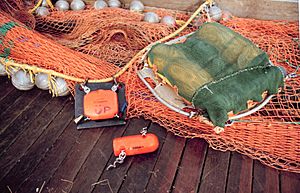Fishing trawler facts for kids
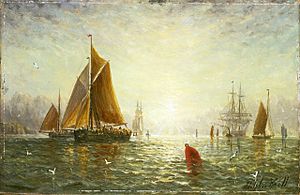
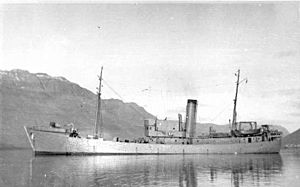
A fishing trawler is a special kind of fishing vessel (boat) that catches fish by dragging a large net called a trawl through the water. This fishing method is called trawling. Trawlers can pull their nets along the bottom of the sea or in the middle of the water, depending on where the fish are. Some trawlers can even pull two or more nets at the same time!
There are many different types of trawling nets and equipment. They vary based on local traditions, the type of seabed, and how big and strong the trawler is. A trawler can be a small open boat or a huge factory ship that processes fish right on board. Some nets are designed to crawl over rocky seabeds using heavy rubber wheels.
What are Modern Trawlers Like?
Modern trawlers are usually strong boats with a deck. Their main building, called the superstructure (which includes the wheelhouse and living areas), can be at the front, middle, or back of the boat. These boats often have powerful winches, advanced electronic navigation systems, and sonar to help them find fish. The fishing equipment can be very simple or very high-tech, depending on the boat's size.
How Trawlers Haul Nets
Modern trawlers use machines to pull in their heavy nets. Special winches and net drums are placed on the deck. These machines help control the strong wires (called towing warps) that pull the nets. They also store the wires when they are not being used for fishing.
Electronics on Trawlers
Today's trawlers use a lot of modern electronics. This includes equipment for navigation, communication, and finding fish. They also have sensors to control and monitor the fishing gear. The type of equipment depends on the trawler's size and what kind of fishing it does.
Much of this equipment can be controlled from the wheelhouse or bridge. Smaller trawlers have a wheelhouse where the captain sits, surrounded by screens for navigation, communication, and fish detection. Bigger boats have a bridge with a main control area and a co-pilot's seat. Modern systems show all important information on one screen.
Navigation tools like autopilot and GPS help the boat move around in harbors and at sea. Radar can be used, for example, when two trawlers work together to keep the right distance from each other. Communication tools range from basic radios to advanced maritime distress systems. Fish finders, like echosounders and sonar, help locate schools of fish.
While trawling, special sensors are used to help control the net. These are often called "trawl monitoring systems."
- Net sounders (or "trawl eyes") show how many fish are near the net's opening. They also show how much space is around the net and its bottom.
- Catch sensors tell the crew how full the end of the net (called the cod end) is getting.
- Symmetry sensors help make sure the net is shaped correctly for the best fishing.
- Tension sensors measure the pull on the wires that drag the net.
Storing and Processing Fish
Modern trawlers keep their caught fish cold. At the very least, fish are stored in boxes with ice or in a chilled storage area. They are kept fresh by using ice or cold seawater, or by freezing them into blocks. Many trawlers also process the fish right on the boat. The bigger the trawler, the more likely it is to have fish processing facilities.
For example, the fish might first go through machines that sort and wash them. Then, they might be automatically gutted and cut into fillets. Very large "factory trawlers" can even make fish oil and fish meal. Some can even have canning plants on board!
Other Features of Trawlers
Crew living areas are usually below the wheelhouse. They often have bunks with special sides to stop people from rolling out in rough seas. There's often a need to dry wet clothes, as shown by an old sign in a steam trawler's boiler room that said: "Do not dry oil frocks over the boiler."
Types of Trawlers
Trawlers can be grouped in different ways. For example, by their design, the type of fish they catch, or the fishing method they use. Here, we'll look at how the FAO classifies them, which is by the gear they use.
Outrigger Trawlers
Outrigger trawlers use long poles, called outriggers or booms, to pull their nets. These poles are usually attached to the mast and stick out over the sides of the boat during fishing. Each side can pull one or two nets. Outrigger trawlers can have their main building (superstructure) at the front or back. Winches on deck help pull in the catch.
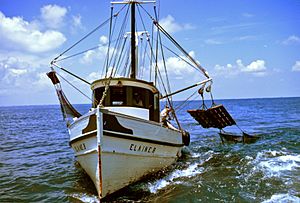
- Outrigger trawlers with the main cabin at the front and the working deck at the back are often used to catch shrimp. The winch is usually behind the cabin, and the wires go through guides to the poles sticking out.
- Outrigger trawlers with the main cabin at the back and the working deck in the middle are usually beam trawlers (see below). These use large beams to hold the nets open.
Outrigger trawlers use different kinds of fish finders to locate fish, depending on their size.
Beam Trawlers
Beam trawlers are a type of outrigger trawler. They have their main cabin at the back and the working deck in the middle. They use very strong outrigger booms on each side. Each boom pulls a beam trawl, which is a net held open by a strong beam. This design makes it easier to store and handle the large beams. The outriggers are controlled from a special frame or mast in the middle of the boat. The winch is at the front of the cabin, and the wires go through guides to the booms.
Beam trawling is common for catching flatfish in the North Sea. These boats have equipment to pull the net aboard. They typically use an echosounder and sonar to find fish.
They are medium-sized, powerful boats that can pull nets at speeds up to 8 knots. To prevent the boat from tipping over if the net gets stuck on the seabed, they have special winch brakes and safety release systems on the booms. For safety, the engine power of bottom trawlers is often limited.
Otter Trawlers
Otter trawlers use special boards called otter boards to keep one or more nets spread open horizontally. These nets can be pulled in the middle of the water or along the bottom. Otter trawlers can be very small, like sailing canoes, or huge "supertrawlers."
Otter trawlers usually have two large frames (gallows) at the back with towing blocks. The towing wires run through these, and each wire is controlled by its own winch. Medium and large trawlers often have a ramp at the back to pull the net onto the deck. Some trawlers pull two nets side-by-side, using three wires, each with its own winch. Some otter trawlers also use outriggers to pull one or two nets from each side.
Usually, otter trawlers have their main cabin at the front, but it can also be at the back or in the middle. The gallows are at the back corners, or there's a large frame (gantry) at the stern for operating the otter boards. Trawlers that catch fish in the open ocean (called pelagic trawlers) can use pumps to empty the fish from the end of the net.
Pair Trawlers
Pair trawlers are two trawlers that work together. They pull a single net between them. They keep the net open horizontally by staying a certain distance apart while towing. This means they don't need otter boards. Pair trawlers can catch fish both in the middle of the water and along the bottom.
Their main cabin is usually at the front or in the middle, with the working deck at the back. Pelagic pair trawlers can also use fish pumps to empty the net.
Side Trawlers
Side trawlers deploy their net over the side of the boat. The towing wires go through blocks hanging from a gallow at the front and another at the back. Usually, the main cabin is towards the back, the fish storage area is in the middle, and the winch is at the front of the cabin. A special crane (derrick) might be used to help launch the end of the net from the side. Until the late 1960s, side trawlers were very common for deep-sea fishing in the North Atlantic. The 1950s side trawler, Ross Tiger, is now preserved in Grimsby, England. These trawlers were used for a long time but are now being replaced by stern trawlers. Some side trawlers still in use have been updated with net drums.
Stern Trawlers
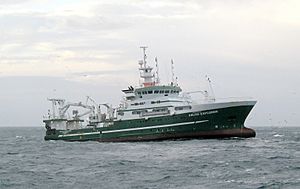
Stern trawlers are boats that launch and pull in their nets from the back (stern). Larger stern trawlers often have a ramp at the back for this. However, smaller stern trawlers and those that catch fish in the open ocean (pelagic) often don't have a ramp. Stern trawlers are built to work in most weather conditions. They can fish alone, either in the middle of the water or along the bottom. Two stern trawlers can also work together as pair trawlers. The main cabin is at the front, with the working deck at the back. At the stern, there are gallows or a gantry (a large frame) for operating the otter boards.
Any fish processing usually happens in special rooms on deck or below deck. A "wet fish" stern trawler keeps the fish fresh in ice or chilled seawater. A "freezer" stern trawler freezes the fish into boxes or blocks. A "factory" stern trawler processes the catch even further. A pelagic stern trawler might use fish pumps to empty the net.
Freezer Trawlers
Most trawlers that fish in the open ocean (far from land) are freezer trawlers. They have special equipment to preserve fish by freezing them. This allows them to stay at sea for a long time. They are medium to large trawlers, similar in design to stern or side trawlers.
Wet Fish Trawlers
Wet fish trawlers keep their fish fresh (wet) in the storage area. The fish are kept in boxes covered with ice or with ice in the hold. These trawlers must operate close to where they will unload their catch, as they can only stay at sea for a limited time.
Trawler/Purse Seiners
Trawler/purse seiners are special boats designed to do two types of fishing: trawling and purse seining. Their deck equipment, including the winch, can be changed to work for both methods. The blocks, davits (small cranes), gallows, and rollers are set up so they can control the lines for both purse seining and trawling. This design helps reduce the time it takes to switch between the two methods. These boats are usually called trawlers because trawling requires more power.
During both World War I and World War II, some countries turned regular fishing trawlers into small warships. They also built new ships based on trawler designs. These "naval trawlers" were usually armed with a small naval gun and sometimes depth charges. They were used for patrolling, protecting other ships, and clearing mines from the water.
Images for kids
See also
 In Spanish: Arrastrero para niños
In Spanish: Arrastrero para niños




